Where Do The Best Coffee Beans In The World Come From? (Part 1)
by Bryan Albuquerque
Welcome to Coffee Culture Worldwide, the Indonesian edition.
In this article, you can discover the rich history of Indonesian coffee, take a glimpse of the Indonesian coffee production, experience each unique type of Indonesian coffee and perhaps encourage your taste buds to try a coffee made from poop. Yup, poop.
Contents
The History of Indonesian Coffee
Coffee was introduced to Indonesia in the 17th and 18th centuries by the Dutch during their colonial rule.
A shipment of arabica coffee seeds were sent to test the soils in 1969. However, due to flooding, the coffee plants did not mature. A second shipment of seedlings were sent in 1699. Plants started to flourish throughout the country and in 1711, the first export of coffee to Europe was made.
Indonesia quickly became a dominant country exporting coffee worldwide. Up to this time, arabica coffee was predominantly shipped from Arabia and Ethiopia.
Fastforward to today, the coffee industry provides a fair share of Indonesia's economy. Most of the farms growing coffee are owned by small shareholders or individual farmers. Up to 90% of the coffee is organic.
The development of the Indonesian coffee industry has resulted in colorful coffee culture.
Indonesian Coffee Production
There are three distinct regions that produces Indonesian coffee. Each produce varying flavours of coffee bean due to the soil content, cultivation methods, and geographical locations.
Java
Java is Indonesia's largest coffee producer. It is known to produce some top quality arabica beans. The beans coming from Java can be stored for two to three years which gives them a fuller, rich taste.
Sulawesi
Coffee beans coming from Sulawesi takes on a traditional method of production. When these Indonesian coffee beans are harvested, they undergo the "dry method" of processing. The dry method involves putting the beans on a large tarp or concrete pad to be dried beneath the sun, often taking several weeks. The beans must be turned every two hours which is done be hand. This method produces a coffee that is full bodied, sweet and smooth.
Sumatra
Here's a name you may be familiar with. Coffee coming from Sumatra, Indonesia is some of the world's most famous and high qualities. You might have seen them on the market. Does Mandheling or Ankola ring a bell? These Indonesian coffees have low acidity with a heavy, full body.
Indonesian Coffees
Indonesia serves a variety of delicious coffees. The following are some of the most popular brews you can find in the streets of Jakarta, Yogyakarta, and Bali.
Kopi Tubruk (Plain, Brewed Coffee)
In Indonesia, the Kopi Tubruk, a plain brewed coffee, is the most common coffee cupping enjoyed by locals and travellers alike. This coffee is so popular that some companies have packaged the perfect amount into little sachets and distribute them to countries like China, Malaysia, and Singapore.
This Indonesian coffee is far from your the typical cup of coffee which you might be used to. Here's how to make a cup of the Kopi Tubruk:
- Take two to three teaspoons of fine or medium ground coffee and put it into a cup.
- Boil water then add it to the cup.
- Stir, mixing the water and the coffee grounds together.
- Wait for a few minutes for the coffee to infuse with the water and for most of the grounds to settle to the bottom.
- Drink up! But, don't drink the remaining mud at the bottom of the cup (or do, but you've been warned).
This simple coffee cupping can be enjoyed alone or served for guests.
Here's a quick demo video for how to make Kopi Tubruk:
Kopi Joss (Charcoal Coffee)
Kopi Joss, known as charcoal coffee, is a speciality Indonesian coffee. After a cup of coffee has been brewed to perfection (likely using the style of Kopi Tubruk), a burning piece of charcoal is added to the cup.
The name "joss" is given to the coffee because the word resembles the sounds of the charcoal as it is submerged into the coffee.
If you're visiting Indonesia, the best place to find charcoal coffee will be at the food vendors with the carpets. Pick out your favorite Indonesian foods, or pick them at random, then order a kopi joss and enjoy the flavours of this unique coffee cupping.
By the way, some consider this charcoal coffee to be a novelty of Indonesia. But, does the coffee taste of charcoal? Put one in your cup to find out!
Here's a video showing the process of this "charcoal" coffee.
Kopi Jahe (Ginger Coffee)
The Kopi Jahe, of ginger coffee, is an Indonesian specialty coffee mostly found in Java. This coffee is brewed using ginger and palm sugar. It has a strong, sweet taste and is used for it's believed medicinal properties. You can find many Javanese sipping on a hot cup of ginger coffee when they have the flu.
Because of this coffee's sweetness and ginger infused flavor, this may be the coffee that converts a tea lover forever. If not, this just might be the perfect coffee cupping to cure the common cold?
Indonesian "Poop" Coffee
The best should always be saved for last. Indonesia has a very unique coffee that has become one of the priciest on the market worldwide. Quite literally, this coffee is made from poop. But, before you go spitting your coffee all over your keyboard or smart device, keep reading to learn more.
There is a special creature, called the Kopi Luwak (i.e. Asian Palm Civet), that gets fed coffee berry seeds. As these berries pass through the animal's digestive tract, the enzyme inside the stomach changes the coffee and gives it a "special" taste. The beans go through a kind of fermentation process that is said to alter the taste of the bean.
Would you try a cup of poopy coffee cupping?
Read more about the Kopi Luwak and Indonesian coffee here
Final Thoughts
The Indonesian coffee culture is robust and booming. It's cultivated taste and rich history will add new excitement to your coffee cupping and coffee culture. Enjoy!
In order to answer the question "Where do the best coffee beans in the world come from?", let us begin with a look at the following useful graphic, which depicts the areas which are best suited to growing coffee around the world.
These great coffee-growing areas around the world are related to temperature and climate, as well as other factors, and as a whole it is known as the "Coffee Bean Growing Belt".
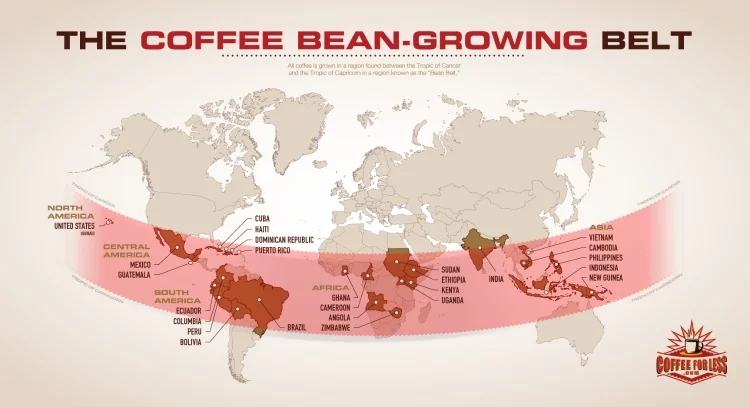
For some, this image of the "Bean Belt" may be a familiar sight. For others who may not be familiar with the whole Bean Belt concept, its pretty easy to look at this map and see a general trend which gives us with the overarching answer to our question, namely; tropical climates.
The most bountiful coffee plant, known as the coffea arabica plant, supplies the world with up to 80% of its coffee and is native to Ethiopia.
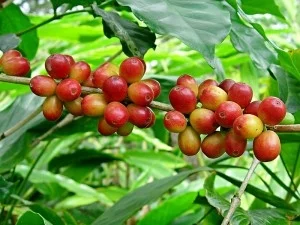
For this special plant to grow and supply us with coffee, certain conditions must first be met. These conditions must include: warmer weather year round, plenty of sunshine, and a good amount of moisture.
Keep in mind, these are the general conditions which promote arabica bean coffee plants, but there are more specific conditions which are just as crucial, which we will describe shortly.
Here is a video which shows the growing and planting of an arabica coffee bean plant, in case you are interested in trying to grow some arabica coffee yourself.
Typically, the kinds of regions which are known to be the most coffee-friendly are commonly found between the Tropic of Cancer and the Tropic of Capricorn.
In the above video, which was recorded in the UK, is not part of this Coffee Belt region, which doesn't mean coffee can't be grown there at all, it simply means the conditions for growing coffee there are less than ideal eg. not naturally tropical.
Along this demarcation we call the Coffee Belt, there are about 75 countries that are much more suited to growing coffee beans than any other.

So, with a quick glance back at our Bean Belt picture, one might assume that there are plenty of prime locations for the best coffee beans in the world to grow.
Of course, a true aficionado knows this is not really the case, as the arabica plant is rather fickle in terms of where exactly it likes to thrive. Yes, it can and does grow in each of these places, but not without the hard work put in by coffee farmers.
Many of the regions in which the coffea arabica plant actually grows and beans are harvested on a regular basis has many different and sometimes unpredictable variables and certain conditions for growing which affects the annual crop's success, and, ultimately, the taste of the coffee we drink once it is shipped to us in other parts of the world. While we simply have to wait patiently for our premium coffee, Mother Nature is busy contemplating whether this year's crop will be easy…or difficult.
Three more specific factors that go a long way to determining what qualifies the best coffee countries in the world. These conditions will include:
- Soil Quality
- Amount Of Rainfall
- Altitude
Although each of these three factors are critical in the growth of the coffea arabica plant, the flavor of the beans can be most allocated to one thing in particular: altitude.
The following graphic should give you an idea of the correlation between altitude and some of the flavors or notes that occur at different altitudes.
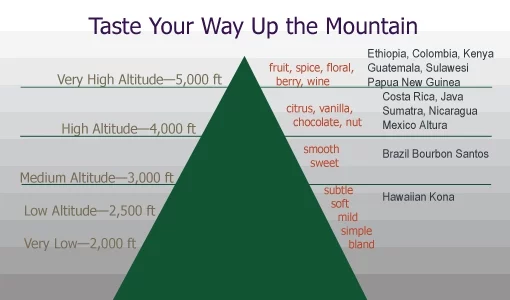
Overall, altitude is crucial because beans which grow at lower altitudes have a tendency to over ripen. Receiving too much moisture is another risky proposition for a coffee plant growing at a lower altitude, due to lack of drainage.
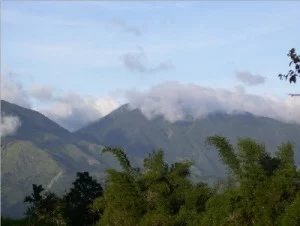
This leads to a higher level of quality from beans grown at a higher altitude, which is often mentioned as a general indicator of quality by farmers and coffee bean companies. In fact, sometimes farmers go to such lengths that they will grow plants of the side of a 60 degree slope just to get to those coveted higher peaks, which sounds a little bit dangerous, doesn't it?
Of course, only experienced coffee farmers from these regions in the Bean Belt know how to harvest what are considered some of the best coffee beans in the world, but that shouldn't stop you from trying to grow your own coffee plants yourself, should you so desire to try.
Watch this quick video to see someone harvesting coffee from seed to cup:
Now that we've looked at what conditions must be in place to grow the coffee plant, lets get back to our original question: "Where Do The Best Coffee Beans In The World Come From?"
Let us start with the Americas, and more specifically…
Jamaica

Jamaica is most well-known for its delicious Jamaican Blue Mountain coffee beans, which are some of the best tasting coffee beans in the world, and is often referred to as the "champagne of coffees". In the high peaks of the Blue Mountains which dominate eastern Jamaica near Kingston is where these coffee beans grow. According to some, including James Bond, who named it his favorite in Live & Let Die, these mountains are the home to the world's best known and best arabica coffee beans in the world, bar none.

What makes this coffee so damn good? For starters, the Coffee Industry Board of Jamaica inspects and certifies that all of their coffee is up to their high standards.
You may also recognize Jamaican Blue Mountain coffee beans by the distinctive barrels it is often packed and shipped in, which is distinctly different from the coffee sacks we normally think of when picturing coffee being transported. In fact, these wooden barrels have become a globally recognized symbol for providing the best coffee in the world.
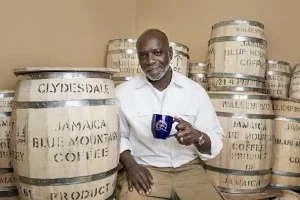
Jamaican Coffee History
All Jamaican Blue Mountain coffee is derived from the Arabica Typica plant, which are all direct descendants of the original plants which were first brought to Jamaica by Governor Nicholas Lawes, who served as Jamaica's governor from 1718 to 1722.
Prior to Governor Lawes getting his hands on the arabica plant, as it happens, the very first arrival of coffee to this region has an interesting tale attached to it. Enter one French infantry captain Gabriel-Mathieu Francois D'ceus de Clieu, who was in 1720 stationed in Martinique, but needed to return to France for personal reasons at this time.
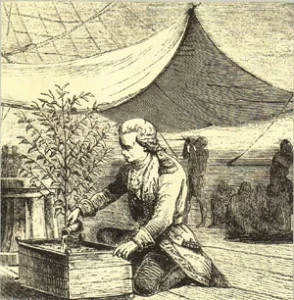
With the help of a charming lady-friend, our hero de Clieu managed to obtain, and then transport, a single arabica seedling from France to Martinique in 1723, thereby introducing coffee to the regions of the Carribean, Mexico, Central America, and South America.
As legend has it, he had to improvise a greenhouse of sorts on his ship during the long voyage, and also, he had to contend with a fellow voyager who was his sworn enemy (who tried to steal part of the plant), not to mention actual pirates coming to blast his ship at sea! It seems like this transcontinental journey of the arabica plant was a dramatic one indeed.
Intriguing history aside, in order for present day Blue Mountain coffee to be certified as such, it needs to be cultivated at an elevation of between 1800 to 5500 feet, where altitudes within this range tend to produce a better, more robust bean due in part to the mists that roll over the mountains and protect the coffee plants from the burning light of the sun. In other words, we're talking about a special climate which is able to produce one of the best coffee beans on the planet. With this level of unparalleled quality of coffee bean, we get a richer, more full-bodied, and unforgettable cup of coffee.
We also have the famous Northeast trade winds to thank for the great taste of Blue Mountain coffee beans, as these winds help to cool down the temperatures on the mountains where the coffee plants grow, and slow down the maturation of the coffee cherry, leading to a better tasting flavor and more sumptuous aroma.
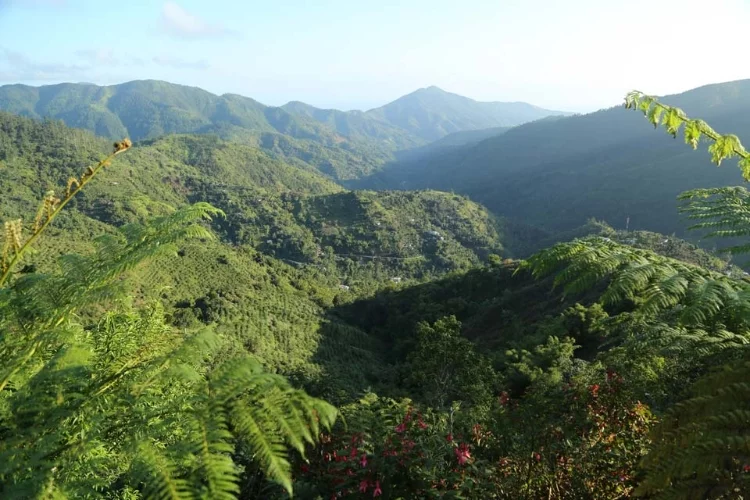
Blue Mountain Peak
All that said, in this mountainous region north of Kingston, the soil isn't always as productive and rich as other areas of the world, and so there is some stress put on the plants as they grow. Rather than view this as a detriment, it is said that this kind of terrain provides a kind of tough love for the bean, giving it its nuanced, well-balanced taste, with a lack of bitterness and low acidity.
Jamaican coffee bean harvesting has been compared to wine-making, where certain wines are sometimes aided by specific environmental challenges. In fact, no one ever said harvesting coffee was easy. The people who farm coffee sometimes do so out of necessity, and so they are used to hard work and the challenges coffee farming can bring.
In Jamaica, there are many different estates that farm Jamaican Blue Mountain, or JBM coffee for short, each of which produces its own distinct flavor profile, just like a wine vineyard. Blue Mountain coffee is described as the "quintessential coffee", and, as rare as it can be to find authentic JBM at a good price. But you have to be careful, as not all Jamaican coffees sold online can claim to be the real deal, so be sure to check the user reviews first.
Here is a short but detailed video documentary about Jamaican Blue Mountain which will definitely make you want to try it out if you haven't already.
Up Next…
Hawaii
The Big Island of Hawaii is really the only region in the United States that supplies the world with homegrown, quality coffee beans, due to its location in the Bean Belt we talked about before.
Specifically, it is the Kona region which produces a flavorful yet mellow, aromatic kope(Hawaiian for "coffee") bean - which are always in demand because of their relative scarcity and delicious taste.
Here's a great video showing how to make a cup of coffee from scratch using Coffea Arabica beans, shot on site on the Big Island itself!
Outside of Hawaii, true Kona coffee is somewhat hard to come by because essentially certain companies like to claim they're selling 100% Kona coffee, but in some cases they might not be, since true pure Kona coffee is, like we said, rare and extremely pricey.
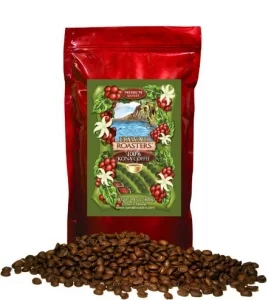
For instance, we are big fans of Hawaii Roasters' 100% Kona coffee, as it is whole bean, locally grown, and hand-picked, but as you can see, you pay more for the higher quality. That's fine with us.
There are multiple grades of Kona coffee, with names like Kona Select, Kona Extra Fancy, Kona Number 1, Peaberry Prime, and many more being bandied about, but one must be vigilant if we want true Kona coffee. Often, coffee referred to as "Kona Blends" are simply that, blends of different kinds of coffee such as Brazilian or Columbian with perhaps only 10% Kona beans.
Which is why the state of Hawaii now requires that authentic Kona coffee display clearly: "100% Kona Coffee", so as to avoid confusion with lesser products, as illustrated by the crest below:
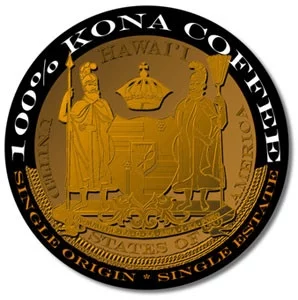
* If you don't see this crest, its probably not 100% Kona
Here's a great video which shows what its like to get down and dirty on a Kona coffee farm. From this video you will see that harvesting coffee is an involved process.
Some farms, like the family-run Mountain Thunder 100% Kona coffee farm has a special recipe for getting premium Kona coffee beans to grow; its a fertilizer which is a delightful melange of donkey poop, seaweed, ground up coffee trees, and cherry skins. To get the best coffee beans in the world, these folks have gotten the distribution of the fertilizer down to an exact science, as distributing it incorrectly can result in damaging the coffee tree. Also, as we see here in this video, there are a number of steps to making sure that Kona coffee beans are always going to be one of the best coffee beans on Earth.
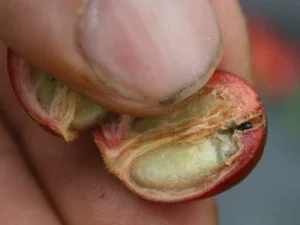
In terms of true Kona coffee being hard to get a hold of in places outside of Hawaii, we ought to mention the threat in recent times of the much-loathed pest, the coffee berry borer beetle. In Hawaii, this is a very serious problem, which destroys crops and, in turn, drives up the prices for Kona coffee.
If you are interested in learning more about the berry borer beetle, and what coffee farmers in Hawaii are doing to prevent them from causing any more damage, take a look at this instructional video below meant to educate Hawaiian coffee farmers. Although this video is specifically aimed at coffee farmers, it can't hurt for the public to learn more about this as well.
Here is yet another Bean Belt graphic - this time, we have the Kona Coffee Belt, which we picked up from bluehorsekona.com which depicts Kona, Hawaii's own bean belt:
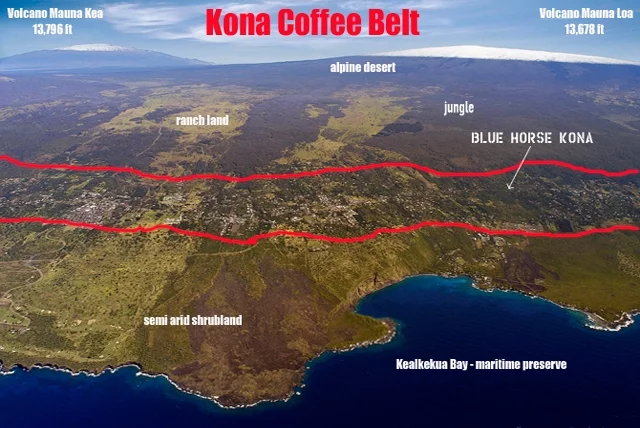
The thing about Kona coffee is that its among the most expensive types of single origin coffee you can buy. In 2010, authentic single origin Kona coffee was fetching up to $50 per pound!
If you are new to coffee and are wondering what exactly single origin means (click the link for a Wiki definition), basically it just means coffee that is grown in one particular geographical location, such as on a specific farm, or at a particular latitude. To our left is Hans, a single origin coffee farmer from Lyman Kona Coffee Farms in Hawaii, busy picking beans on his "Mauka" farm at 2100 feet elevation.
If you find the topic of single origin coffee fascinating and want to read more about it, there's a great article here on the topic.
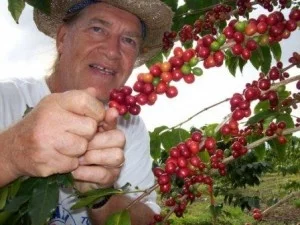
Hawaiian Coffee History
In terms of its coffee history, Hawaii did not get a fruitful crop of coffee plants until this man…
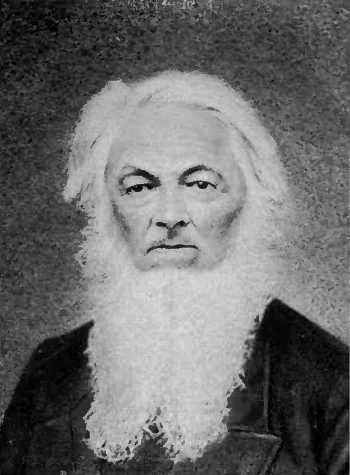
…a missionary by the name of Reverend Samuel Ruggles managed to successfully plant a crop in the Kona district of Hawaii in 1828 via some trimmings he had, succeeding where others before him had failed to grow or harvest any substantial plantings on the island.
The rich, black volcanic soil of Mauna Loa and Hualalai is said to give the Hawaiian coffee beans their much-admired flavor, in combination with the temperate weather including plenty of sun, low winds, clouds, and rainfall, followed by milder nights.
But it is the small farms, as coffee expert Kenneth Davids once said in his detailed appraisal of Kona coffee, that are responsible for the most impressive coffee on the island, and which also inspired the following inspired quote by Mark Twain in 1866:
"Kona coffee has a richer flavor than any other, be it grown where it may and call it by what name you please."
There are very specific techniques which are used with Hawaiian Kona coffee, such as allowing the cherries, once picked, to ferment at two separate altitudes. Another trick of the trade is to allow the beans to dry for 14 days to reach an optimal moisture level of 9.5-12.5 %.
"Sweet" or "complexly fruity" are descriptors that are have been associated with the flavor of Kona coffee, but we may also talk about its roundness, vibrancy, brightness, mildness, and even the buttery quality it has. We might even call some "powerfully acidy and authoritative", as Kenneth Davids once said.
Here's an interesting video which shows the inner workings of an actual Kona coffee cupping competition, which is basically a tasting competition by experts. There are all sorts of expert techniques for tasting the coffee, and letting the coffee "reveal itself". Quite fascinating, really…
Similar to wine which always comes from the same trusted vineyard year in and year out, single origin Kona will always have a slightly different flavor depending on the particular harvest, but the quality of the farm usually retains its consistency.
Mexico
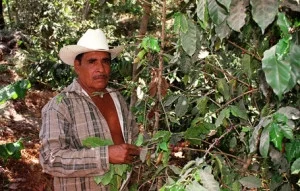
We can't forget Mexico in regards to the best coffee beans in the world coming from the Americas, with its southern region being responsible for the majority of its fine arabica beans.
According to many coffee aficionados, the taste of Mexican coffee to be primarily be described as being "nutty", "rich", and "chocolatey". Once again, the flavor profiles will differ from farm to farm, but this seems to be the general consensus on Mexican coffee flavor notes.
Vera Cruz, Oaxaca, and Chiapas are three areas renowned for their great coffee, because this is where many of the smaller farms are located.
Huge quantities of Altura, Liquidambar MS, and Pluma Coixtepec coffee is exported to the United States annually. In fact, where does the U.S. get most of its organic coffee from these days? You guessed it: Mexico.
Below is a short film depicting day to day coffee production in Mexico.
Mexican Coffee History
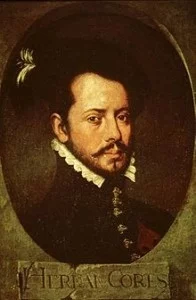
The story of coffee's arrival in Mexico is far less romantic than, say, that of Jamaica. We don't really have a dashing French infantry captain like Gabriel-Mathieu Francois D'ceus de Clieu who seemed to risking his life to bring a single coffee plant to the New World, or a man like Reverend Samuel Ruggles, who was beloved by the Hawaiians so much that they called him "Keiki" (child).
Instead who we might place at the center of our coffee history of Mexico is a man who Wikipedia basically states there aren't enough objective records about to determine his motives for doing what he did, or even his personality type. Whether he's some sort of national hero or just a really bad guy, the world may never fully decide, but if waging war, lusting after women, keeping slaves, stealing treasure, and generally trying to plot, scheme, and conquer as much as possible is any moral indicator, you might think the person we're talking about here wasn't exactly a sweetheart.
If you haven't guessed from our somewhat vague but historically fact-based description, or from his picture over on the upper left with his name under it, we're talking now about famous Spanish Conquistador and eventual conqueror of the Aztec empire, Hernán Cortés.
Because of Cortés, we now have modern day Mexico (then called New Spain), which includes many things that previously did not exist in this part of the world, courtesy of the Spaniards, such as: horses (which the Aztecs thought were dragons when they first arrived), oranges, sugar cane, and…yes, coffee.
Since Mexico has always been rich in minerals such as gold and silver, and more recently as a major source of oil, coffee was never at the top of the list for things that the ruling class in Mexico cared to develop when it first arrived. It wasn't until the late 1700's, a full five decades after it had arrived and began to flourish in Jamaica and Hawaii, did coffee really catch on in plantations in Vera Cruz.
Suffice it to say, once coffee began to flourish in Mexico, the two became inextricably linked. Here is a short documentary of what coffee production is like in recent times in Vera Cruz, Mexico.
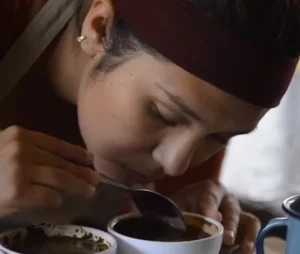
In this both inspirational and highly educational video, we can see that coffee is not only an important natural resource in modern day Mexico which must be guarded at all costs, as well as an important commodity and international export, but that coffee production in Mexico is actually something which is integral to the very fabric of their society. Clearly it touches on all aspects of life there, from education, to ecology, to economy, and the list goes on. As such, it is no surprise that knowledge of the importance of coffee is passed from one generation to the next, and that people there generally understand what goes into superior coffee production. Mexican coffee producers are well aware of what it takes to produce world class coffee, which is why we've listed them as producing some of the best coffee beans in the world.
For instance, did you know that in Mexico, the best coffee beans are the result of several types of large tree, like the zempehuatl tree to our left, plus the insects, flora, fauna, and wildlife in any particular region? By the way, the zempehuatl is an endangered species…so endangered that Google doesn't even know about it. Now that is endangered. 🙁
Meeting the right balance of ecological and environmental conditions could be said of any successful coffee growing region, but it is particularly relevant to Mexicans, as there has historically been a struggle to decide which type of natural resource is the most sustainable, resulting in the cutting down of many large, old trees.
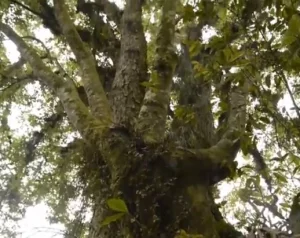
Common sense should tell us that cutting down large, old trees is never a good thing, but this especially is not a good thing for coffee, as the conditions under which the best coffee beans are grown requires that these shade-providing trees not be cut down, even if it seems profitable or necessary at the time.
With all this heavy talk of environmental strife, why don't we lighten things up (literally) and take a look at this truly amazing video of a blue fiery coffee waterfall. Wow!
To keep the quality on par with other leaders in coffee, there is the Mexican Coffee Institute (INMECAFE), which is a government agency that responsible for regulating Mexico's huge coffee industry. And that's a lot of coffee production to regulate, since, as of the year 2000, Mexico was producing 60% of the world's organic coffee. Also, when compared to Hawaii, Mexico is absolutely huge, with thousands of hectares of land devoted to coffee production and thousands of small farms producing coffee to meet the demands of a coffee-loving culture to the north.
One of the best coffee brands to come out of Mexico is its Altura organic coffee. Altura means "heights", and that's where this tasty bean grows; at high altitudes, producing a deep milk-chocolate-like flavor with good acidity.
Similiar to premium Kona coffee, Altura demands a higher pricetag, but its devotees would suggest (read their reviews here) that it is well worth it. If you get your Altura directly from a farm, you are most likely in for some of the best-tasting coffee of your life.
If you're looking to buy green coffee beans for roasting, you couldn't do much better than these premium green unroasted Altura beans, which brews a medium bodied cup of exquisite coffee and tastes like hazelnuts.
By supporting the coffee farmers of Mexico in purchasing fair trade organic coffee beans, we can help ensure that the farmers are able to continue doing what they do best, which is to produce the best coffee beans in the world for everyone to enjoy for as long as possible!
To conclude our section on Mexico, as well as the first part of our article series which searches for the best coffee beans in the world, we shall leave you with a short video on how to make "Mexican Coffee", which is a delicious alcoholic coffee beverage that is perfect for a summer's night.
Continue to Part 2 (Brazil, Colombia, Peru)
Related Posts
 |
 |
 |
 |

About Bryan Albuquerque
Bryan Albuquerque is a coffee lover and vaping advocate who writes reviews and information about coffee accessories and KYG. A former coffee addict, Bryan traded his morning fix for an electronic cigarette in an effort to quit smoking, and has never looked back. He's dedicated to helping others make the switch to vaping, and believes that it's one of the best decisions anyone can make for their health.
Thoughts on "Where Do The Best Coffee Beans In The World Come From? (Part 1)"
 |
 |
 |
 |
Get FREE Coffee Gifts now. Or latest free grinders from our best collections.
Disable Ad block to get all the secrets. Once done, hit any button below
 |
 |
 |
 |